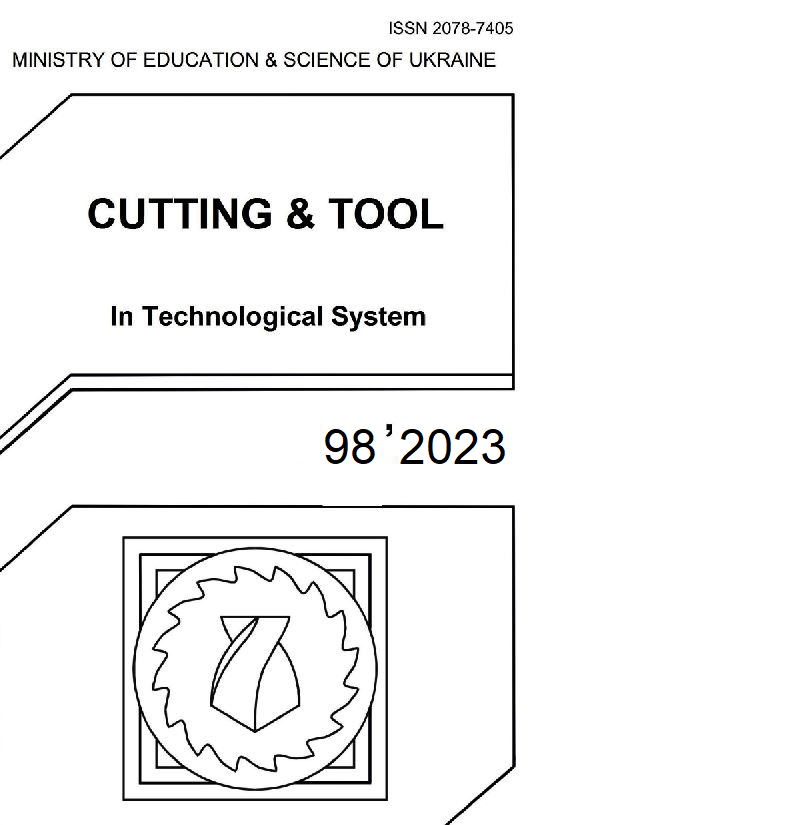INVESTIGATION OF FACE MILLED SURFACE TOPOGRAPHY ON C45 WORKPIECE ASSUMING MOVEMENT AT 30° AND 60° TO FEED DIRECTION
DOI:
https://doi.org/10.20998/2078-7405.2023.98.12Keywords:
face milling, surface roughness, distribution of roughness, direction-dependent characterization of topographyAbstract
When surfaces with anisotropic texture are moved in different directions related to their assembled counterpart during operation, the friction conditions change, as they are determined by the lay of the topographies. In the article, contributing to the exploration of this characteristic, we analyze the inhomogeneity of the topography on a face milled plane surface with a symmetrical setting in sections at an angle of 30° or 60° to the feed direction. Roughness profiles are recorded at 13 points located equidistantly from each other in each measurement plane, and the degree and distribution of the roughness deviations are determined on the surface.
References
Liu, G., Huang, C., Zhu, H., Liu, Z., Liu, Y., Li, C. The modified surface properties and fatigue life of Incoloy A286 face-milled at different cutting parameters. Materials Science and Engineering: A. 2017. vol. 704. pp. 1 – 9.
Molnár, V. Wear Resistance of Hard Turned Surfaces. Cutting & Tools in Technological System. 2022. vol. 96. pp. 65 – 72.
Molnár, V. Tribological Properties and 3D Topographic Parameters of Hard Turned and Ground Surfaces. Materials. 2022. vol. 15. № 7. ArtNo. 2505.
Grzesik, W. Prediction of the functional performance of machined components based on surface topography: State of the art. Journal of Materials Engineering and Performance. 2016. vol. 25. pp. 4460 – 4468.
Mitsyk, A., Fedorovich, V., Grabchenko, A. Main technological factors determining the efficiency and quality of the vibration process. Cutting & Tools in Technological System. 2022. vol. 96. pp. 131 – 137.
Sharma, N., Gupta, K. Influence of coated and uncoated carbide tools on tool wear and surface quality during dry machining of stainless steel 304. Materials Research Express. 2019. vol. 6. № 8. ArtNo. 086585.
Parhad, P., Likhite, A., Bhatt, J., Peshwe, D. The effect of cutting speed and depth of cut on surface roughness during machining of austempered ductile iron. Transactions of the Indian Institute of Metals. 2015. vol. 68. № 1. pp. 99 – 108.
Sztankovics, I. Analysis of Rotational Turning in Precision Finish Machining (in Hungarian). Miskolc, Hungary: István Sályi Doctoral School of Mechanical Engineering Sciences, 2022. 96 p.
Balaji, M., Venkata Rao, K., Mohan Rao, N., Murthy, B. Optimization of drilling parameters for drilling of TI-6Al-4V based on surface roughness, flank wear and drill vibration. Measurement. 2018. vol. 114. pp. 332 – 339.
Ferencsik, V., Varga, G. The Influence of Diamond Burnishing Process Parameters on Surface Roughness of Low-Alloyed Aluminium Workpieces. Machines. 2022. vol. 10. ArtNo. 564.
Molnár, V., Szabó, G. Designation of minimum measurement area for the evaluation of 3D surface texture. Journal of Manufacturing Processes. 2022. vol. 83. pp.40 – 48.
Molnár, V., Sztankovics, I. Analysis of Roughness Parameters Determining Tribological Properties in Hard Turned Surfaces. Hungarian Journal Of Industry And Chemistry. 2021. vol. 49. № 2. pp.77 – 84.
Molnár, V. Asymmetric Height Distribution of Surfaces Machined by Hard Turning and Grinding. Symmetry. 2022. vol. 14. ArtNo. 1591.
Ferencsik, V., Varga, G. The Effect of Burnishing Process on Skewness and Kurtosis of the Scale Limited Surface. Cutting & Tools in Technological System. 2022. vol. 97. pp. 83 – 90.
Felhö, C. Investigation of surface roughness in machining by single and multi-point tools. Aachen: Shaker Verlag, 2014. 188 p.
Smith, G.T. Cutting Tool Technology: Industrial Handbook. London: Springer-Verlag, 2008. 559 p.
Arizmendi, M., Jiménez, A. Modelling and analysis of surface topography generated in face milling operations. International Journal of Mechanical Sciences. 2019. vol. 163. ArtNo. 105061.
Chuchala, D., Dobrzynski, M., Pimenov, D., Orlowski, K., Krolczyk, G., Giasin, K. Surface roughness evaluation in thin EN AW-6086-T6 alloy plates after face milling process with different strategies. Materials. 2021. vol. 14. № 11. ArtNo. 3036.
Varga, G., Kundrák, J. Effects of Technological Parameters on Surface Characteristics in Face Milling. Solid State Phenomena. 2017. vol. 261. pp. 285 – 292.
Kundrak, J., Felho, C. Topography of the machined surface in high performance face milling. Procedia CIRP. 2018. vol. 77. pp. 340 – 343.
Nagy, A., Kundrak, J. Analysis of the change in roughness on a face-milled surface measured every 45° direction to the feed. Cutting & Tools in Technological System. 2021. vol. 95. pp. 29 – 36.
Nagy, A., Kundrak, J. Analysis of inhomogeneity of surfaces milled with symmetrical, down-milling, and up-milling settings. Development in Machining Technology: Scientific – Research Reports vol.10. Cracow, Poland: Cracow University of Technology. 2022. pp. 51 – 62.
Nagy, A., Kundrak, J. Changes in the values of roughness parameters on face-milled steel surface. Cutting & Tools in Technological System. 2020. vol. 92. pp. 85 – 95.
Kundrak, J., Nagy, A. Investigation of Surface Roughness Characteristics of Face Milling. Cutting & Tools in Technological System. 2019. vol. 90. pp. 63 – 72.
Downloads
Published
Issue
Section
License
Copyright Notice
Authors who publish with this Collection agree to the following terms:
1. Authors retain copyright and grant the Collection right of first publication with the work simultaneously licensed under a Creative Commons Attribution License that allows others to share the work with an acknowledgement of the work's authorship and initial publication in this Collection.
2. Authors are able to enter into separate, additional contractual arrangements for the non-exclusive distribution of the Collection's published version of the work (e.g., post it to an institutional repository or publish it in a book), with an acknowledgement of its initial publication in this Collection.
3. Authors are permitted and encouraged to post their work online (e.g., in institutional repositories or on their website) prior to and during the submission process, as it can lead to productive exchanges, as well as earlier and greater citation of published work.

